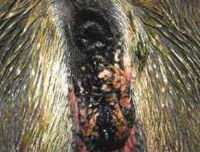Difference between revisions of "Coital Exanthema - Donkey"
m (Text replace - '|rspace={{Donkey}} |pagetype=Donkey }}' to '|pagetype=Donkey }} {{infotable |Maintitle = This section was sponsored and content provided by '''THE DONKEY SANCTUARY''' |Maintitlebackcolour = B4CDCD }} [[Cat) |
|||
| Line 42: | Line 42: | ||
}} | }} | ||
[[Category:Donkey]] | [[Category:Donkey]] | ||
| + | [[Category:Viral Skin Infections - Donkey]] | ||
Revision as of 13:00, 4 March 2010
| This article has been peer reviewed but is awaiting expert review. If you would like to help with this, please see more information about expert reviewing. |
Introduction

The donkey is susceptible to EHV 3 infection (coital exanthema) and this is usually regarded as a transient venereal infection.
Clinical Signs
It can affect the penis of the breeding male and the perineal skin and vulva of the jenny. The classical symptoms are an acute, florid inflammatory response with transient vesicles and secondary infection some days after coitus.
Treatment
Treatment is limited to topical application of soothing antibacterial creams and, if the area is significantly painful, human haemorrhoid creams are useful because they contain antibiotic and local anaesthetics.
Sexual rest is important because it can spread rapidly, and a rest for up to three weeks will usually allow the stallion to recover and become noninfectious.
Control
There does seem to be a carrier status in the males in which immunity is solid for some years.
Many Herpes virus infections have a latent capacity and so recrudescence is likely.
References
- Knottenbelt, D. (2008) Skin disorders In Svendsen, E.D., Duncan, J. and Hadrill, D. (2008) The Professional Handbook of the Donkey, 4th edition, Whittet Books, Chapter 8
|
|
This section was sponsored and content provided by THE DONKEY SANCTUARY |
|---|